|

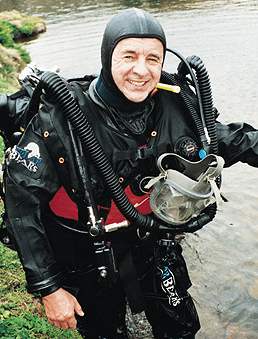
What makes Stealth so special?
UCI Editor John Bevan
visits Divex in Aberdeen to try out the Stealth rebreather, and to look
at other products the company makes for the military diving market.
Following a period of steady decline in the offshore diving industry,
particularly in the North Sea, Divex took the decision in 1995 to enter
the defence industry. This began with the winning of a contract to build
sixteen recompression chambers for Royal Navy diving and submarine
rescue operations. The company's progress since then has been
outstanding by any standards. Today Divex is the largest
supplier/manufacturer of diving equipment to the UK MoD, and has
extensive experience of supplying military diving organisations
worldwide.
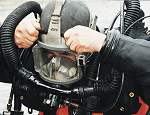 Divex's military rebreather, Stealth, is a prime example of the
company's ability to identify a customer's requirement and come up with
the most successful solution, even when set against all the established
competition.
Divex's military rebreather, Stealth, is a prime example of the
company's ability to identify a customer's requirement and come up with
the most successful solution, even when set against all the established
competition.
The story of Stealth started in 1995 when the Royal Navy put out a
tender inviting proposals to provide the next generation of Explosive
Ordnance Disposal (EOD) and Special Forces rebreathers. Using experience
gained from the manufacture of the Secondary Life Support SLS bail-out
rebreather used by saturation divers at depths up to 450msw, Derek
Clarke (Managing Director) and James Bruce (Senior Project Engineer)
started with a clean sheet and began designing from the bottom up what
is now beyond doubt the world's most advanced military mixed gas
rebreather.
Rigorous
In 1998 Divex proudly announced that Stealth had entered service with
the Royal Navy after two years of rigorous testing against other systems
on the market. Today the RN has 30 sets in service and a further 25 will
be added by the end of the year.
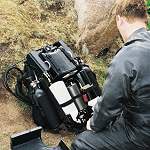 Since its introduction, Stealth has been internationally
acknowledged and accepted. A major coup was the adoption of the set last
year by the Federal German Navy for Mine Counter Measures and EOD
operations. This was achieved in the face of stiff competition from both
Draeger and Carleton Technologies. After 12 months of testing, the
German Navy has already taken delivery of its first consignment, the
total order being 205 complete systems over three years.
Since its introduction, Stealth has been internationally
acknowledged and accepted. A major coup was the adoption of the set last
year by the Federal German Navy for Mine Counter Measures and EOD
operations. This was achieved in the face of stiff competition from both
Draeger and Carleton Technologies. After 12 months of testing, the
German Navy has already taken delivery of its first consignment, the
total order being 205 complete systems over three years.
The French Navy has now tested Stealth to 80m at sea and 102m in
wet chamber
trials; and other navies are also opting for the set, with the
Italian, Spanish and Singapore navies being the latest.
Divex's Stealth is an amazing success story!
So what is so special about the Stealth rebreather that has
catapulted it to the forefront of rebreather technology? There was only
one way to find out - suck it and see!
I eagerly accepted the invitation from Dave Smith, Divex's Sales
and Marketing Director, to visit the company's headquarters in Aberdeen
and to try the set out.
By coincidence, Lt. Luis Nunes, a Mine Clearance Diving Officer of
the Portuguese Navy was also carrying out an evaluation of the Stealth
during our visit, including some diving trials. The diving site selected
was a flooded quarry outside Peterhead. The water temperature was a
generous 5¼C. Well, it was the middle of June after-all!
We had the Divex ÔA-team' in attendance. Our Diving Supervisor was
Bob Thompson, Senior Technician, and diving partner Paul Haynes,
Military Equipment Specialist and an ex-military diver who participated
in the UK MoD testing of Stealth back in 1996. After our Portuguese
guest had concluded his dive, I suited up and paid attention to the
pre-dive briefing from Paul and Bob.
Simplicity
This is when I pleasantly discovered the relative simplicity of
Stealth's operation. I quickly appreciated the effort that must have
been invested in its design because, despite the complexity of the set's
internal operation, the primary user interaction was reduced to
monitoring a single LED light inside the mask. For all normal operation
this was a steady green light, which meant that the diver had absolutely
nothing to do to operate the set.
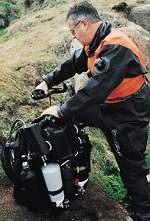 A secondary liquid crystal data display module was conveniently
hung alongside the right arm. The display included current and maximum
depth, elapsed time, and the status of a variety of components and
consumables. Most of this data did not require the attention of the
diver, and only if the green LED mask light started to blink or turned
to red did the diver have to refer to the display module to check the
set's operation.
A secondary liquid crystal data display module was conveniently
hung alongside the right arm. The display included current and maximum
depth, elapsed time, and the status of a variety of components and
consumables. Most of this data did not require the attention of the
diver, and only if the green LED mask light started to blink or turned
to red did the diver have to refer to the display module to check the
set's operation.
As we descended, Stealth automatically raised the partial pressure
of oxygen (PO2) from 0.5bar at the surface to 0.9bar at our 12m bottom'.
Had we continued deeper, the Electronic Oxygen Controller would have
continued to gradually raise the PO2 to 1.3 bar. From 18msw down, the
PO2 would then have remained fixed at 1.3 bar regardless of the depth.
With changing depth, the speed of response of the mixture to
maintain this partial pressure is well ahead of any competitors because
the Electronic Oxygen Controller was designed to control within a
miniscule 0.02 bar of the oxygen set point. The PO2 is monitored by
three independent sensors. The dual redundancy electronics package
operates a voting system between the three sensors, so that if one began
to fail it would be voted out by the other two.
The next thing I noticed as I prepared to dive was the relatively
light weight of the set, a mere 23kg. When I put on the full-face mask,
I was also impressed by the imperceptibly low work of breathing. Paul
pointed out, and required me to demonstrate, the simple switch operation
on the front of the oral-nasal mask for the changeover from closed
circuit to open circuit bail-out - a fundamental safety feature.
Once in the water, or perhaps I should say liquid peat, we made our
way over granite boulders down to 12 metres. As we sank into the dark
brown gloom, I mused that by adding a little flavouring we could sell
this water as Guinness. As the depth increased, I could sense the extra
diluent gas (air in this case) being automatically added into the
breathing loop to compensate for the compression of the counterlungs. On
the bottom, Paul carried out routine checks.
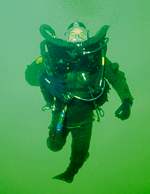 Green LED
Green LED
A steady green LED light in my mask reassured me that everything was
working normally and that the set was doing all the thinking for me. I
could relax and devote my entire attention and both hands to the job in
hand (crawling over granite boulders). The set's low profile meant I
could hardly tell it was there. It was so quiet that I could distinctly
hear Paul's occasional comments to the surface over the Divex
through-water communicator.
After a circuit or two of the bottom (the boulders all looked
remarkably similar and the bottom was singularly lacking in the usual
supermarket trolleys or other useful reference points, we began our
ascent.
The set could have given me 3-6 hours at the bottom of the quarry,
and with the controlled oxygen partial pressure of 1.3 bars it could
have given me a maximum no-decompression depth of 18msw - very
beneficial I was told for Special Forces divers covertly locking in and
out of submarines.
Ascending was a slightly novel experience because this time, in
addition to ensuring the adequate venting of my drysuit and Stealth
integrated buoyancy compensator, some additional attention had to be
paid to the venting of the counterlungs. A standard exhaust valve had to
be opened to ensure continued comfort of breathing during the ascent as
the gas in the breathing circuit expanded.
Following a most enjoyable dive, and useful quarry reconnaissance,
I soon realised that I had become an instant convert. This was what the
Stealth rebreather was all about. The next step was to return to the
luxury of Divex's indoor training tank to try out yet another of the
Stealth's unique features.
Once back at Divex's headquarters, I was shown around their
state-of-the-art lecture room. Then, as if driven by osmotic pressure,
we ended up at the training tank.
Rigged once more in the Stealth, I climbed down the ladder into the
tank.Waiting for me at the bottom was what looked like a twin SCUBA set.
Add-ons
However, this was a special rig called the Supplementary Breathing
Supply (SBS). Among other add-ons, it had a special whip fitted with a
quick-connect-disconnect termination. The primary purpose of the rig was
as an additional emergency gas supply for decompression stops, for the
SBS would normally be deployed beneath the dive boat.
The exercise for me was to disconnect the open-circuit emergency
bail-out supply hose on the front of the Stealth Dual Mode Full Face
Mask (while continuing to breathe in the closed-circuit mode), connect
to the emergency SBS supply, then switch to the external emergency gas
supply on open circuit. As of this point, the diver has a plentiful
supply of open-circuit gas for his decompression, including 100% oxygen
for the shallower stops.
The next diving exercise was a demonstration of the Divex Digicom
1000 Diver Through Water Communicator (DTWC). For this I was kitted out
in a SCUBA air set with full-face mask. A small communications
transceiver was strapped to the side of the air cylinder, the straps of
the mask housing the two earphones. This tiny through-water
communications unit can operate over a range of up to 1000 metres, and
following a competitive tender it is now in service with the Royal Navy,
the last of over 800 units being delivered last year.
Once back in the water, I tested communications with Paul -
perfect! There was a press-to-talk button on the front of the mask.
This demonstration did not take very long because there was not
much I could talk about from the inside of a tank, other than how
remarkably clean it was.
With the wet session over, it was time for the debriefing. I was
particularly interested in the design of the rebreather, and I wanted to
know what made it such a superior set.
First, the Stealth has been designed to be as simple as possible to
operate and to maintain in the field without specialist technical
support. For example, no tools are needed to dismantle or assemble the
set. Second, whatever hypothetical component or even procedural failure
occurs, there is sufficient redundancy and/or fail-safe modes to permit
the dive to be safely aborted. You only need to see the 2-inch thick
Failure Mode, Effect and Criticality Analysis documentation to see the
amount of work that has gone into this. The report documents the
potential failure modes of every single component that makes up the
system from a second stage diaphragm to a resistor on a printed
circuit-board. Using this information, failure modes critical to the
safety of the diver were designed out.
Rapid
response
The rapid response of the set to changing depth and consequential
adjustment of the mix to maintain the oxygen partial pressure is a major
safety feature that greatly reduces the risks of hypoxia, hyperoxia and
decompression sickness - diving risks with which we are all familiar
when using open-circuit equipment, but which are further increased when
using rebreathers. The facility to switch instantly to open-circuit on
the diluent mix with a simple turn of the valve at the oral-nasal mask
is a fundamental emergency safety feature.
Yet another extremely important feature in the routine 3-monthly
maintenance check of the set is the ability to check the linearity of
response of the three oxygen sensors, in situ, up to 2.5 bars PO2. It is
understood that other manufacturers check only up to 1 bar (ie,
calibration in 100% at sea level).
Another of the many unique features of Stealth is the Data
Acquisition capability. After diving, a PC can be linked to the set to
download all information regarding the status of the equipment
throughout the dive. This is extremely useful to military dive planners.
The set comes in two different configurations - the Stealth SF for
the Special Forces, and the Stealth EOD for Explosive Ordnance Disposal
and Mine Counter Measures.
The tour of the Divex facilities was an impressive experience.
Where the Stealth sets were being assembled and tested, James Bruce,
co-designer of the Stealth, showed me a bank of 10 sets undergoing final
assembly.
Meanwhile, in separate workshops, I saw the assembly lines of
several of the other military products, including:
- Oxymax Oxygen Rebreather. This provides up to 3 hours' endurance
and is simple to use and maintain.
- Enclosed Space Diving System (ESDS). This is for diving in
extremely confined places, such as the space between the casing and
pressure hull of a submarine.
- Dirty Harry. This breathing system is used by military and
commercial divers in polluted waters.
- Diver's Electronic Beach Reconnaissance Aid (DEBRA). An electronic
compass, Doppler velocity log, GPS, automatic logging of depth and
height above the seabed, all fitted into a hand-held board,
revolutionises beach reconnaisance.
- DCC refurbishment and maintenance. Divex provides refurbishment
and maintenance for many RN compression chambers.
- Enclosed Mine Lift Bag (EMLB). The Mine Lift Bag has entered the
21st century with Divex's EMLB, which is now computerised and endowed
with its own Ôintelligence'. It can vary its inflation time between 0
and 90 minutes and delay its inflation for up to 45 days.
- Diver Hand Heating Equipment. For protracted operations in cold
water to maintain manual dexterity and protect the health of hands.
- Therapeutic Hyperbaric Oxygen Rebreather (THOR). This is designed
for injured divers who require hyperbaric oxygen treatment.
- Counter-terrorist equipment. Divex also supplies a range of
maritime counter-terrorist equipment used by Special Forces who have
responsibility for assaulting offshore installations should they fall
into terrorist hands.
What is
DIVEX?
The Divex vision statement reads as follows: "For Divex to be the
first choice of international underwater operators for products, support
services and technology".
In order to consolidate its position in the diving industry and
deliver on this vision statement, Divex has, over the years, acquired a
considerable number of well-known companies. On the diving equipment
side, these include:
General Diving Systems
Submarine Products
Sub Sea Services
Underwater Instrumentation
Foundrometers
Spiro Diving Services
Dive Dynamics
Kinergetics
Gas Services
Circle Offshore
UWI Circle
Plus, on the hyperbaric systems side:
Aqualogistics
Kinergetics
Clearbook Engineering
Magpie Engineering
Mara Engineering
Offshore Marine Engineering
Seaforth Engineering
Hyox
|